As an Amazon Associate I earn from qualifying purchases.
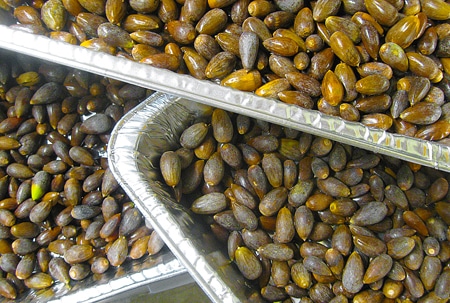
Another year of cooking, experiments and insights, and I still don’t think I’ve come even close to unlocking the potential of acorns. Yes, acorns. You know, those things that fall from oak trees?
Readers of this space know I’ve written extensively on collecting and eating acorns, how acorns are eaten in other world cultures, and on the important role acorns play in a wild diet. I also have a series of acorn recipes elsewhere on this site. What else was there to write?
Lots, apparently. For starters, there are nearly as many ways to get the bitter tannins out of the acorns as there are people who eat them, which is to say, um, at least a dozen. Different species of acorns also taste different, and will act differently in the kitchen. Some are oily, some more floury, some light, some dark.
At their core, however, the best reference point I can give you for all acorns is the chestnut. Both nuts are slightly mealy, share the same color, have a similar nutrient content and act pretty much the same in the kitchen; chestnuts taste a little sweeter, but acorns caramelize easier.
A few weeks ago I went to my acorn spot, a grove of giant Valley oaks that regularly drops tons of acorns — not an exaggeration. This year, however, the trees did not set. No acorns to speak of. None. Oaks will do this, however, so a forager needs to have several spots scoped out in case one doesn’t pan out.
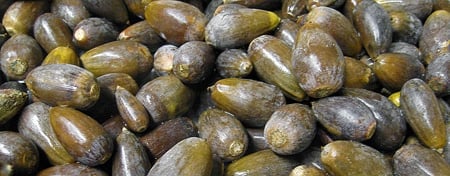
Fortunately this year I had help. A friend of my friend Jim’s has a horse paddock underneath lots of oaks. Oaks that were dropping acorns something fierce. Every morning she picked up the acorns, because apparently horses get sick if they eat too many. Did I want them? Hell, yeah I did! So I met Jim and he handed over nearly 30 pounds of acorns.
Sadly, almost a third had the tell-tale hole in them that means an acorn weevil ate the nut. These acorns went outside, food for squirrels. Another portion were from an oak that set tiny acorns, not really worth bothering with. But the bulk of the remainder were acorns from California’s blue oak, a “sweet” oak species whose acorns require minimal processing.
Last season I ran out of acorn flour, so I was determined to make more this time. And this time I decided to use cold water to leach out the bitterness in the acorns; last season I used boiling water. Boiling water happens to leach out some important starches in the acorns, and the resulting flour won’t stick to itself as well as flour made with cold water.
This matters, because acorn flour lacks gluten — so you need every little bit of stick-to-itive-ness you can get. I also found that cold-leached flour tasted more acorn-y, and was lighter in color.
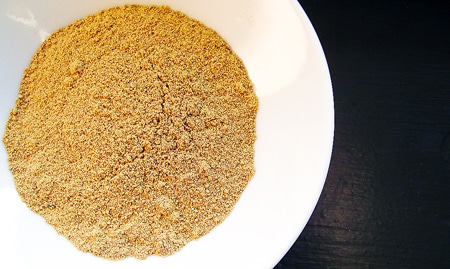
The catch? It takes many days to make cold-leached acorn flour. Here’s how:
- Crack your acorns into a bucket of water, then extract them from the shells into a large bowl of water. Keeping the nuts under water helps preserve the light color — acorns oxidize and turn dark easily.
- Fill a blender half full with acorns and cover with fresh water. Buzz the hell out of them, until you have what really, really looks like a coffee milkshake. Far be it from me to suggest a truly excellent practical joke right now…
- Pour the mix into large jars (big Korean kimchee jars are great) about halfway and top off with more water. Seal the jar and shake everything up. Put the jar in the fridge.
- Every day, pour off the water, replace with fresh water, shake well and set back in the fridge. You’re done when the acorns taste boring, not bitter. The blue oaks took a week.
Now you need to dry your flour. Start by pouring everything into a colander with cheesecloth set in it. Gather the cheesecloth and squeeze it tight to extract as much water as you can.

Now spread the still-damp flour on a large rimmed cookie sheet. Break up any clumps. Blue oaks have a lot of oil in them, and you will get “acorn butter,” a very light, clay-like substance that you can skim off or incorporate into the flour. I mix it in, as it has a lot of flavor. Acorn butter clumps a lot, so you will need to break it up small.
Put the cookie sheet in an oven set on “warm.” Don’t get the heat higher than that, or you will bake your flour, and you don’t want that. A food dehydrator ought to work, too, but I don’t have one.
Finally, you need to grind the dried flour one more time. Use a heavy duty coffee or spice grinder. Grind the flour into a fine powder, which took me about 35 seconds. Store in the fridge or freezer, as the fats in acorn flour go rancid rapidly.
Sounds like a lot of work, right? It was. A huge amount of work that made me very, very aware about how we take regular wheat flour for granted. I can guarantee you I will not be tossing around acorn flour the way I would with all-purpose. It’s too precious.
And good. I made acorn pasta last year with the hot-leached flour, so I decided to switch to acorn spaetzle this year with the cold-leached flour. I served the little dumplings with venison sauerbraten.

I used the sauerbraten recipe I developed for Elise at Simply Recipes, but I cooked the venison roast sous vide at 140 degrees for six hours. It was meltingly tender and perfectly cooked. I highly recommend this technique.
You can really taste the nuttiness and the warm, “dark” flavor of the acorns in the spaetzle. It was my favorite acorn dish so far.
Until I made acorn soup.
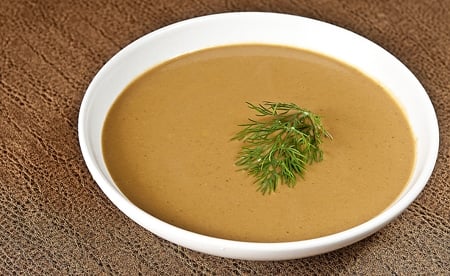
I did not make this with acorn flour. I did it with acorn “grits” I made after hot-leaching the last of my acorn stash. You hot-leach the bitterness from acorns by putting the nuts into a kettle of water and bringing the water to a boil. Pour off the water and repeat until the acorns are no longer bitter. It took me six changes of water to get all the bitterness out.
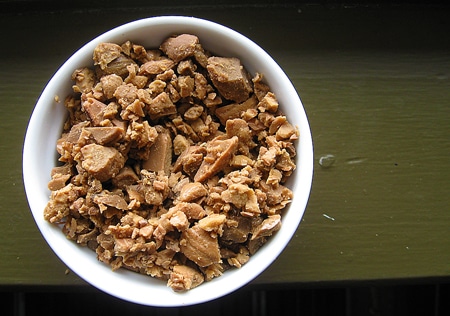
Why make grits? Well, you can add them to a regular soup like you would a potato — I did this with a grouse soup I made last year — or you can use it as a base for a smooth soup, like the one I did this week. This soup started with carrots, onion, dried porcini and celery cooked in butter, then I tossed in some pear brandy and wild goose stock, added the acorn bits and simmered for an hour. A trip to the blender to puree came next, then a little water, a little salt, a dollop of creme fraiche and you’re done.
Was it good? You bet it was good! The soup has a woodsy, almost caramel taste to it, is smooth as a baby’s behind and smells like winter. If you go to the trouble to make this soup, I guarantee you will not be disappointed.
MORE ON ACORNS
- Acorn Muffins, from Book of Yum
- Acorn Bread, by Amber Dusick
- Petit Chef’s Spiced Pickled Acorns




Hank:
I usually sous vide my venison as well, but I have a question about this receipe. Did you simply put the marinated roast in the bag, or did you add some of the liquid? Generally one would put in the meat only but because with the oven method Sauerbraten the sauce is made from the cooking liquid I wondered if you’d need to mimic that for SV. Meat only, or meat & marinate?
Unbelievably interesting! SousVide cooking for wild game is a no brainer (did Canada Goose confit a bit ago)- but acorn flour? You have me at the peak of my culinary curiousity. Bravo!
🙂
V
Laura: Look for white oaks. They have the lowest levels of tannin of all the oaks in your area.
Any idea which is the “sweetest” variety of oak in southern New England? We’re in southern RI and would very much like to try making acorn flour.
Well that was an interesting read! I’d be half-tempted to try this just to steal food from the marauding squirrels in our neighborhood; but then they might be more tempted to do what they’ve done so often–eat the mortar from between the bricks of my house.
@Joshua–thanks for teaching me a new word!
Hank, have you tried using Lye to remove the tannins/bitterness similar to how you use it with olives?
Autumn: Not a fan of that jelly. It’s well, really weird, texturally.
Steve: Give it another go. Gibbons never really dove into acorns with an open mind, which is interesting given how much he did with other stuff. Think of acorn flour as a gluten-free flour. It can sub in for rice flour, chickpea flour, chestnut flour, corn flour etc.
My ex-wife and I tried acorns back in the 70’s.. Ala Euell Gibbons.
As hard as we tried we could never seem to come up with anything that I would
consider edible. After this post I will have to re-visit acorns. Maybe it’s just he Michigan oaks. ??
You make it sound and look so inviting.
Steve
Awesome — you’re so adventurous! Made me laugh out loud when I first opened the post on my reader!
Food chains and foraging are quite new on my radar. So is your site. Hunting is a childhood holdover recently reinvigorated. All of this means I’m thrilled to find new posts here, especially this one. I spent a good hour digging for solid insight on what might be possible with acorns a week ago. Stoked that you have been working at it for a bit now and are so generous (and encouraging) with what you are learning. Keep up the great work in the field and kitchen and writing desk!
Cheers.
Cool post! Who knew?
I found this interesting too: Korean Acorn Jelly
https://www.nytimes.com/2010/10/13/dining/13acorn.html?_r=1&partner=rss&emc=rss
I made acorn gnocchi this year, and loved them so much that I’m ALREADY out of acorn flour. I had a good 10 lbs of acorns. I’m hoping that my spot is still ripe because otherwise I might cry :).
I’ll have to try these spaetzle too. I just love the flavour that the acorn flour gives things.
Balanophagy at its finest! Great post. You missed out on the massive amounts of valley oak acorns at my spot… next year, we’ll both be on top of that, and have acorns coming out our ears.
I’m still waiting until you describe the millionth ton of acorns you process, five years from now. It’ll be a tweet; wanna read it here it goes:
Big bag of acorns on “2000 flushes” mode.